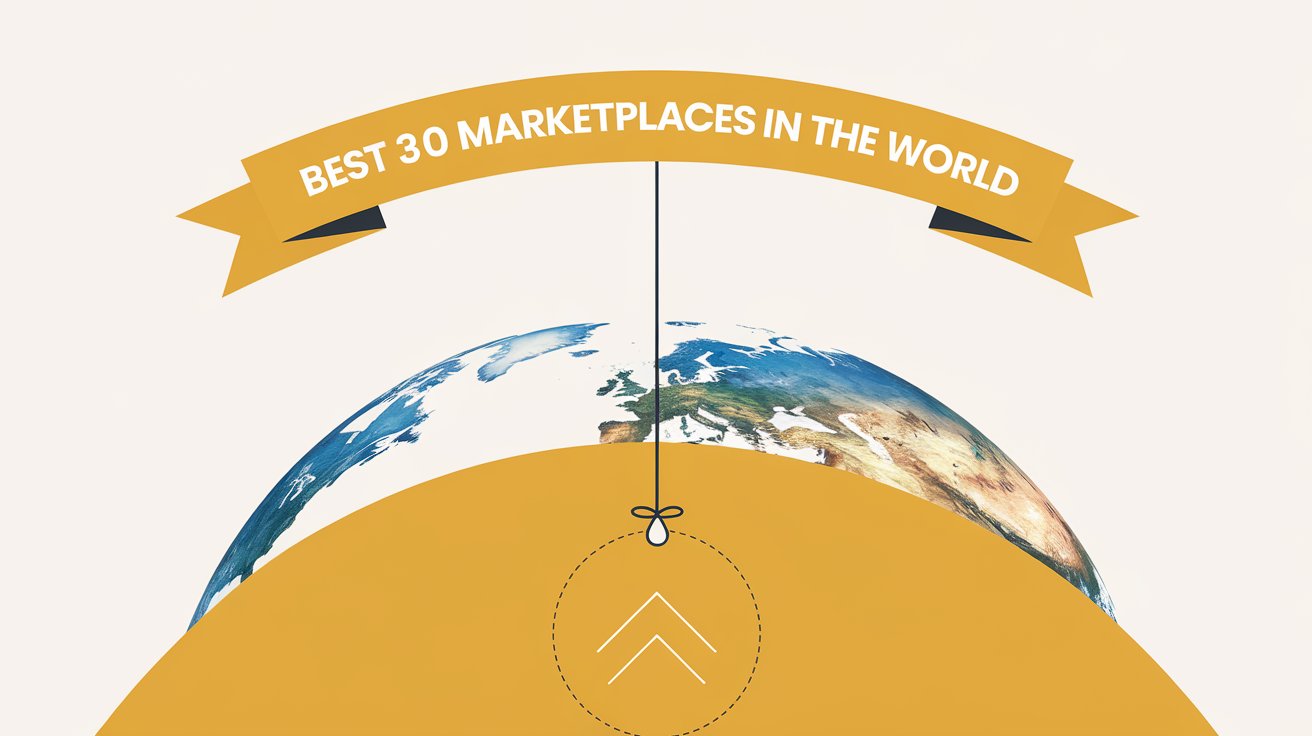Best 30 marketplaces in the world
Written by
Kinga EdwardsPublished on
Explore the best 30 marketplaces in the world. Learn about the best categories, experience differences, and tap into incredible shopping opportunities.

In 2025, global e-commerce retail sales are projected to hit $7.4 trillion, accounting for 24% of all retail sales. That’s a massive market, and positioning your products on established marketplaces can give you a significant slice of that pie.
However, questions arise… Which marketplaces to choose? Which will bring the most benefit? Which are simply the best?
Read this article and find out which marketplaces will help you win.
What makes a marketplace the best?
What exactly makes a marketplace stand out from the crowd?
Is it the sheer number of buyers? The ease of selling? Or maybe the range of products available?
Well, it’s not just one thing. It’s a combination of factors working together to create an exceptional platform.
First, the customer base. A great marketplace attracts a loyal, active audience. Global reach is another key factor. The best marketplaces connect you to international users and don’t limit you to local buyers. Then there’s the product variety. Successful marketplaces strike a balance between offering plenty of options without becoming overwhelming. They also provide strong seller tools – like analytics dashboards, marketing support, or logistics services – that make life easier for businesses.
And let’s not forget customer experience. The top platforms are easy to navigate and make customers feel confident about their purchases. These small details matter more than you’d think.
Ultimately, the best marketplaces are like ecosystems.
They bring buyers and sellers together in a way that feels seamless, trustworthy, and, most importantly, valuable.
So, when you think about the best marketplaces, ask yourself: do they create opportunities or just transactions? That’s the real question.
Why selling on marketplaces is a game-changer for your business
Online marketplaces have become pivotal for business growth, and it’s evident in the numbers – marketplaces’ share has risen from 53% to 55% and is largely driven by Chinese platforms such as Shein (they account for 6% of orders).
But what makes marketplaces such a popular choice? What are the benefits behind them?
Overall, it is about greater convenience, flexibility, and accessibility.
Consider this: Amazon holds a 37.6% share of the U.S. e-commerce market. On the other hand, in the UK, internet retail sales account for 26.2% of all retail sales as of November 2024.
Thus, by listing your products on marketplaces, you’re instantly exposed to millions of potential customers who trust and frequently use the platform.
But it’s not just about reaching more customers. Marketplaces often offer robust fulfillment services that can streamline your operations. They also provide a level of credibility and trust that might take years to build independently. Plus, with the rise of mobile commerce – 75% of consumers complete purchases entirely on their mobile devices – being on a well-optimized marketplace ensures your products are accessible to this growing segment.
The advantages of using marketplaces can be listed and listed, but they all boil down to one thing: marketplaces open doors that were previously closed.
Whether this is due to your small budget, lack of marketing expertise or not enough manpower. Marketplaces automate a lot of processes, provide delivery options, offer analytical tools – they just make a lot of work out of you.
The list of best 30 marketplaces in the World
All right. Let’s eventually check the whole list of 30 best marketplaces in the World. The biggest 10 and more below!
Source: ECDB overview of Top eCommerce Marketplaces Worldwide
1. Amazon
Amazon remains the undisputed leader in global e-commerce, with a staggering $728.782 billion GMV. The marketplace offers everything from electronics to groceries, but its biggest category is Hobby & Leisure (37.1%), making it a key destination for books, gaming, and entertainment. With 50.1% of its sales coming from the U.S., it dominates the domestic market while maintaining strong international reach. Sellers choose Amazon for its massive customer base, extensive logistics support (FBA), and powerful advertising tools.
2. Pinduoduo
Pinduoduo has rapidly gained traction, especially in Greater China, where it generates 100% of its sales. Focused on social commerce, it thrives on group buying deals and specializes in Fashion (56.0%). With an impressive 24.6% growth rate, Pinduoduo is expanding faster than many competitors, proving that community-driven shopping models are here to stay. Sellers benefit from high engagement rates and a strong network effect that encourages repeat purchases.
3. Taobao
Taobao, part of the Alibaba ecosystem, remains one of China’s largest consumer-to-consumer marketplaces. It focuses on Fashion (35.0%), offering a mix of mass-market and independent brands. Despite its -8.0% decline in GMV, it still commands 95.8% of its sales from Greater China. Sellers choose Taobao for its flexible selling structure, which allows individuals and businesses to launch stores without strict entry barriers.
4. Tmall
Tmall, also owned by Alibaba, differs from Taobao by catering to established brands rather than individual sellers. It remains a powerhouse in Greater China (96.1% of its sales are generated in this country) and dominates the Fashion category. Although its GMV declined by 7.6%, it still processes over $500 billion in transactions. Sellers choose Tmall for its credibility, as the platform requires businesses to meet strict quality and branding standards. With strong cross-border capabilities, it also enables global brands to enter China’s lucrative online retail market.
5. JD.com
JD.com is one of China’s largest B2C marketplaces, known for its stronghold in Electronics (45.0%). It dominates the Greater China market as well (99.5%). Unlike Alibaba’s platforms, JD.com prioritizes first-party sales alongside third-party sellers, ensuring high product quality and authenticity. Its efficient logistics network and same-day delivery services make it a preferred marketplace for high-value products. Sellers benefit from JD’s trusted reputation, particularly in categories where authenticity and warranties matter most.
6. Douyin
Douyin, the Chinese version of TikTok, has completely disrupted the e-commerce landscape with live shopping and short-video commerce. The platform specializes in Care Products (28.2%), leveraging influencer-driven marketing to boost sales. With 100% of its GMV from Greater China, it shows how social commerce is redefining how people shop. Its staggering 74.1% growth rate makes it one of the fastest-growing marketplaces. Sellers who tap into Douyin benefit from video-based engagement, viral product discovery, and direct influencer partnerships.
7. Kwai Shop
Kwai Shop, operated by Beijing Kuaishou Technology, is another fast-growing social commerce platform in China. Specializing in Fashion (55.0%), it provides a mix of affordable and trendy clothing driven by short-form video content. The platform saw a 25.6% growth in GMV, proving the effectiveness of video-first selling models. Sellers choose Kwai Shop for its high engagement rates, where product visibility skyrockets through viral content.
8. Walmart
Walmart’s marketplace is a powerful alternative to Amazon, particularly in the United States (91.4% of sales). While it covers multiple categories, its strongest segment is Fashion (19.0%). With a 21.0% increase in GMV, Walmart Marketplace is proving its ability to compete in e-commerce. Sellers appreciate its hybrid model, allowing third-party vendors to reach Walmart’s massive audience while benefiting from in-store pickup and delivery options. Unlike Amazon, Walmart has fewer seller fees, which makes it an attractive platform for those looking to expand in the U.S. market.
9. Shopee
Shopee is Southeast Asia’s leading marketplace, with Indonesia accounting for 26.5% of its sales. The platform’s main focus is Fashion (32.0%). With a 6.8% growth rate, Shopee continues to expand despite competition from Lazada and Tokopedia. Sellers choose Shopee for its localized approach, offering region-specific promotions and flexible payment options like cash-on-delivery. With gamified shopping experiences and aggressive discounts, it keeps customers engaged and returning for more.
10. eBay
eBay remains a big player in global e-commerce, particularly in the United States (42.2% of sales). As well as Amazon, eBay thrives on Hobby & Leisure (26.0%) but it’s also strong in Fashion. Despite a -1.5% decline in GMV, it retains a strong presence due to its auction-based model and international reach. Sellers appreciate eBay’s low entry barriers, thanks to which individuals and businesses can sell without the constraints of strict brand regulations. With a focus on sustainability and refurbished goods, eBay continues to attract value-driven shoppers.
11. Coupang
Coupang is South Korea’s e-commerce powerhouse, handling 99.5% of its sales within the country. Known as the “Amazon of Korea,” it dominates Fashion (31.0%) and offers everything from luxury brands to affordable everyday wear. What sets Coupang apart is its ultra-fast delivery, with many orders arriving within hours thanks to its advanced logistics network. Sellers benefit from high trust in the platform, a loyal customer base, and seamless fulfillment services.
12. AliExpress
AliExpress, part of the Alibaba Group, has built a global reputation as the go-to marketplace for affordable goods shipped directly from China. Unlike Taobao or Tmall, which serve mainly domestic buyers, AliExpress caters to international shoppers, with 19.5% of sales coming from the U.S. Its largest category is Fashion (31.0%) – it attracts bargain hunters looking for low-cost clothing, accessories, and beauty products. Sellers choose AliExpress for its ease of entry, international reach, and growing logistics capabilities like AliExpress Standard Shipping.
13. Shein
Shein has revolutionized the fast-fashion industry and became a global retail force with a 55.1% increase in GMV. It dominates the Fashion category (77.0%) more than any other marketplace! With over 51.5% of sales coming from the U.S., Shein’s rapid product turnaround and influencer marketing have fueled its rise. Shein operates on a direct-to-consumer model and controls everything from manufacturing to shipping. Sellers who partner with Shein gain access to its massive customer base and AI-driven trend forecasting.
14. MercadoLibre
MercadoLibre is Latin America’s largest marketplace, with Brazil leading at 47.4% of sales. Covering a wide range of categories, its biggest segment is Electronics (25.8%). With a 29.9% growth rate, it continues expanding in emerging markets, where digital payments and logistics improvements are fueling e-commerce adoption. Sellers choose MercadoLibre for its localized attitude, including its fintech arm, Mercado Pago, which enables seamless transactions. The platform’s fulfillment services, similar to Amazon FBA, make it a top choice for scaling businesses in South America.
15. Lazada
Lazada, another Alibaba-owned marketplace, is one of Southeast Asia’s biggest e-commerce platforms, particularly in Indonesia (29.7% of its sales). Its main focus is Electronics (29.0%) – it’s a top destination for smartphones, gaming accessories, and home gadgets. The platform saw a 60.3% increase in GMV, highlighting its rapid expansion across the region. Sellers benefit from Lazada’s strong logistics network, which includes its own warehouses and last-mile delivery services.
16. Rakuten
Rakuten is Japan’s leading e-commerce marketplace, processing 97.2% of its sales within the country. It thrives in the Fashion category (36.3%) and offers a mix of local and international brands. Rakuten follows a membership-driven model, where users earn points that can be redeemed across its vast ecosystem, from e-commerce to travel and entertainment. Despite a -2.6% decline in GMV, Rakuten remains a dominant force in Japan due to its deep customer loyalty and extensive seller tools. Businesses that sell on Rakuten benefit from strong branding opportunities, a high-spending customer base, and access to Rakuten’s marketing solutions.
17. Naver
Naver, called the “Google of South Korea,” operates a powerful e-commerce marketplace alongside its search engine and digital services. With 98.6% of its sales coming from South Korea, it’s a go-to destination for online shopping, especially in Fashion (34.0%). Its 4.1% growth rate shows steady expansion, particularly in mobile commerce. What makes Naver unique is its integration with search and social commerce, allowing businesses to attract buyers directly through organic search results. Sellers appreciate its SEO-driven approach, where visibility is tied to high-quality product photos, content, and customer engagement.
18. VIP.com
VIP.com is a Chinese e-commerce platform specializing in discounted and flash-sale fashion items. It processes 100% of its sales in Greater China, with Fashion making up 70.0% of its transactions. The marketplace grew by 12.3% in GMV and shows a strong demand for limited-time deals. VIP.com stands out for its time-sensitive shopping model, where discounts are only available for short windows. Sellers who partner with VIP.com gain access to a deal-hunting audience and a platform designed for high-volume sales.
19. Flipkart
Flipkart is India’s largest e-commerce marketplace, accounting for 100% of its GMV in the country. Its strongest category is Electronics, making it a popular choice for mobile phones, laptops, and accessories. With a 5.4% growth rate, Flipkart continues expanding, supported by Walmart’s backing and investments in logistics. Sellers benefit from Flipkart Fulfillment, which handles warehousing, packing, and shipping, similar to Amazon FBA. As India’s digital economy grows, Flipkart remains a dominant force, especially in mobile-first shopping experiences.
20. Wildberries
Wildberries is Russia’s largest online marketplace, with 93.7% of sales coming from the country. Its Fashion category (38.0%) makes it a key destination for apparel and accessories. The platform experienced a 9.2% increase in GMV and maintained strong growth despite economic challenges. What sets Wildberries apart is its localized payment options and flexible returns. Sellers benefit from low commission fees and direct access to millions of customers across Eastern Europe.
21. Target
Target’s online marketplace is an extension of its massive retail presence in the U.S., where it generates 100% of its GMV. While it sells a variety of products, its strongest category is Hobby & Leisure (24.0%). Despite a -1.0% decline in GMV, Target remains a trusted marketplace thanks to its brand reputation and strong omnichannel strategy. Sellers benefit from high customer trust and access to a loyal, middle-class shopper base. With in-store pickup and same-day delivery options, Target continues to be a strong competitor to Amazon and Walmart.
22. Ozon
Ozon is another of Russia’s leading marketplaces. It specializes in Electronics (34.0%) and attracts a tech-savvy audience looking for smartphones, laptops, and accessories. The platform saw a 69.3% increase in GMV, making it one of the fastest-growing e-commerce companies on the list. Sellers benefit from Ozon’s expanding logistics network, which supports both direct sales and third-party merchants.
23. TikTok Shop
And there’s TikTok Shop – one of the fastest-growing e-commerce platforms globally, with an incredible 354.5% increase in GMV. Its biggest market is Thailand (25.6% of sales), reflecting the strong influence of live shopping in Southeast Asia. The platform specializes in Care Products (42.1%), driven by influencer promotions and viral beauty trends. Sellers benefit from direct integration with short-form video content. With social commerce becoming a key trend, TikTok Shop is rapidly changing how people discover and buy products.
24. Ruten
Ruten is a major e-commerce marketplace in Taiwan, with 100% of its GMV from Greater China. The marketplace experienced a 2.4% growth in GMV, and it’s particularly strong in Electronics. Ruten is known for its C2C and B2C hybrid model, allowing both individuals and businesses to sell products. Sellers benefit from low transaction fees and a highly engaged, tech-savvy audience.
25. Tokopedia
Tokopedia is Indonesia’s largest marketplace – it handles 99.5% of its GMV in the country. It focuses heavily on Fashion (35.0%) and caters to Indonesia’s growing demand for affordable and trendy apparel. Despite a -11.2% decline in GMV, it’s still a critical player in Southeast Asia’s e-commerce space. Sellers choose Tokopedia for its localized marketing, strong logistics network, and seamless digital payment options. As Indonesia’s digital economy expands, Tokopedia continues to adapt with mobile-first shopping experiences.
26. Best Buy
Best Buy is the leading U.S. marketplace for consumer electronics. 92.3% of its GMV comes from the U.S., and the strongest category is Electronics (62.0%). Despite a -7.5% decline in GMV, Best Buy retains a competitive edge due to its expert service, warranty programs, and in-store pickup options. Sellers who join the Best Buy marketplace gain access to a high-spending, brand-conscious audience.
28. Zalando
Zalando is Europe’s leading online fashion marketplace, with 92.0% of its GMV coming from Fashion. Based in Germany (31.0% of total sales), it caters to customers looking for mid-range and premium apparel. Although its GMV declined slightly by -0.2%, it’s one of the top German companies. It remains a dominant force thanks to its strong brand partnerships and seamless return policies. Sellers benefit from a dedicated fashion audience and access to Zalando Fulfillment Services (ZFS), which simplifies logistics. As Europe’s appetite for online fashion grows, Zalando continues to be a key marketplace for brands and retailers.
29. Allegro
Allegro marketplace is Poland’s largest e-commerce platform, with 95.6% of its GMV generated domestically. It excels in Hobby & Leisure (25.0%), making it a top marketplace for books, music, gaming, and specialty goods. With a 15.6% increase in GMV, Allegro is experiencing strong growth in Central and Eastern Europe. Sellers appreciate its low fees, strong customer trust, and extensive payment solutions like Allegro Pay. As Polish online marketplaces expand, Allegro remains a dominant platform for local and international brands.
30. Wayfair
Wayfair is a leading online furniture and homeware marketplace, with 85.2% of its GMV coming from the U.S. The platform’s main category is Furniture & Homeware (43.0%) – it offers all for home decorators, interior designers, and everyday consumers. Despite a 0.2% GMV increase, Wayfair continues to expand its offerings with customizable furniture and augmented reality tools for home planning. Sellers choose Wayfair for its high-value transactions and dedicated home goods audience.
How to choose the right marketplace for your brand?
As you can see, the above marketplaces work for different businesses. They offer many great opportunities, but it depends on which category. Thus, you need to think strategically about what online marketplace to choose.
Here’s how to break it down:
- Understand your target audience
→ Research where your ideal buyers shop.
→ If you target price-conscious customers, platforms like Shein or AliExpress may work.
→ If you sell to eco-conscious shoppers, check out eBay.
- Match the marketplace to your product category
→ Selling fashion? Try Zalando.
→ B2B or wholesale? Alibaba fits the bill.
→ High-end brands? Coupang attracts premium buyers.
- Evaluate fees and costs
→ Check listing fees, commission rates, and fulfillment charges.
→ Amazon and eBay have competitive fees but can add up.
→ Marketplaces like Walmart may have lower selling fees but require approvals.
- Decide on fulfillment needs
→ Need help with logistics? Amazon FBA, JD.com, and MercadoLibre handle storage, packing, and shipping.
→ Want control over delivery? Zalando, eBay, and Allegro let you self-fulfill orders.
At the end of the day, the right marketplace is the one that helps you reach your ideal customers without killing your margins. Choose wisely!
Conclusion
So, is selling on marketplaces the right move for you?
If you’re looking to expand your reach, leverage advanced tools, and tap into the booming e-commerce trend, the answer might just be a resounding yes.
And now you know what marketplaces focus on.
What’s the next step? Choosing the one that aligns with your business goals and customer needs. With the right strategy, a marketplace will become a launchpad for growth.
***


